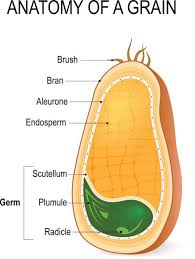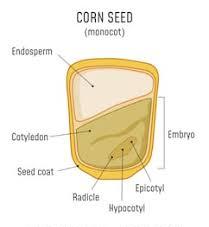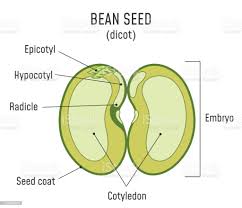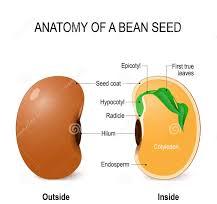TYPES OF SEED- STRUCTURE & FEATURES
INTRODUCTION
General meaning of seed is anything that can be sown, or any part of the crop from which a new crop can grow. The formation of the seed is part of the process of reproduction in seed plants.
TYPES OF SEED
A seed is primarily of two types-
Monocotyledonous seed
- Commonly known as monocots, are grass and grass like flowering plants. Such seed has only one cotyledon and only one outer layering of the seed coat.
- The monocotyledons include about 60,000 species. The largest family in this group is Orchidaceae with more than 20,000 species.
- Poaceae, the grass family is economically the most important family of monocotyledons. Hence, this type is major biomass producer in the field of agriculture. Other economically important monocotyledons are various palms (Arecaceae), bananas and plantains (Musaceae), gingers, turmeric and cardamom (Zingiberaceae), asparagus (Asparagaceae), pineapple (Bromeliaceae), sedges (Cyperaceae) and rushes (Juncaceae), onion and garlic (Amaryllidaceae).

- Most of the horticultural bulbs, plants cultivated for their blooms, such as lilies, daffodils, irises, amaryllis, cannas, bluebells and tulips, are monocotyledons.
Monocotyledons seed consist of following parts-

- Seed Coat: In cereals like maize, the seed coat is membranous and generally fused with the fruit wall, called Hull.
- Endosperm: The endosperm is bulky and stores food. Generally, monocotyledonous seeds are endospermic but some as in orchids are non-endospermic.
- Aleuron layer: It is proteinous outer layer of endosperm which seperates the embryo.
- Embryo:The embryo is small and situated in a groove at one end of the endosperm.
- Scutellum: This is one large and shield-shaped cotyledon.
- Embryonal axis: Plumule and radicle are the two ends.
- Coleoptile and coleorhiza: The plumule and radicle are enclosed in sheaths, known as coleoptile and coleorhiza.
Dicotyledonous Seed
- The dicotyledons are also called Dicots, other group of flowering plants after monocots. Such seed has two embryonic leaves or cotyledons. There are around 200,000 species within this group. Peas, almonds and cashews are examples of dicotyledons or dicot seeds.


Such seed has following parts-
- Seed coat: This is the outermost covering of a seed. The seed coat has two layers, i.e. testa (outer one) and the tegmen (Inner one).
- Hilum:The scar on a seed marking the point of attachment to its seed vessel is called hilum.
- Micropyle: It is a small pore present just above the hilum.
- Embryo: It consists of an embryonal axis and two cotyledons.
- Cotyledons: These are often fleshy and full of reserve food materials.
- Radicle and plumule: They are present at the two ends of the embryonal axis.
Read more…
SEED CLASSES- TYPE AND FEATURES
SEED MEANING- FUNCTION & IMPORTANCE
SEED GERMINATION-PROCESS & FACTORS OF GERMINATION
SEED DORMANCY- DEFINITION, TYPES & IMPORTANCE
SEED DISPERSAL- TYPES AND IMPORTANCE